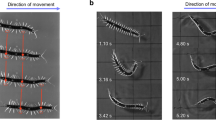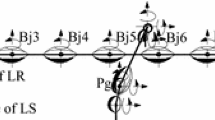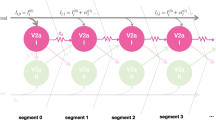Abstract.
In this paper we consider the hypothesis that the spinal locomotor network controlling trunk movements has remained essentially unchanged during the evolutionary transition from aquatic to terrestrial locomotion. The wider repertoire of axial motor patterns expressed by amphibians would then be explained by the influence from separate limb pattern generators, added during this evolution. This study is based on EMG data recorded in vivo from epaxial musculature in the newt Pleurodeles waltl during unrestrained swimming and walking, and on a simplified model of the lamprey spinal pattern generator for swimming. Using computer simulations, we have examined the output generated by the lamprey model network for different input drives. Two distinct inputs were identified which reproduced the main features of the swimming and walking motor patterns in the newt. The swimming pattern is generated when the network receives tonic excitation with local intensity gradients near the neck and girdle regions. To produce the walking pattern, the network must receive (in addition to a tonic excitation at the girdles) a phasic drive which is out of phase in the neck and tail regions in relation to the middle part of the body. To fit the symmetry of the walking pattern, however, the intersegmental connectivity of the network had to be modified by reversing the direction of the crossed inhibitory pathways in the rostral part of the spinal cord. This study suggests that the input drive required for the generation of the distinct walking pattern could, at least partly, be attributed to mechanosensory feedback received by the network directly from the intraspinal stretch-receptor system. Indeed, the input drive required resembles the pattern of activity of stretch receptors sensing the lateral bending of the trunk, as expressed during walking in urodeles. Moreover, our results indicate that a nonuniform distribution of these stretch receptors along the trunk can explain the discontinuities exhibited in the swimming pattern of the newt. Thus, separate limb pattern generators can influence the original network controlling axial movements not only through a direct coupling at the central level but also via a mechanical coupling between trunk and limbs, which in turn influences the sensory signals sent back to the network. Taken together, our findings support the hypothesis of a phylogenetic conservatism of the spinal locomotor networks generating axial motor patterns from agnathans to amphibians.
Similar content being viewed by others
Author information
Authors and Affiliations
Additional information
Received: 12 October 2001 / Accepted in revised form: 16 May 2002
Correspondence to: T. Bem (e-mail: tiaza.bem@ibib.waw.pl)
Rights and permissions
About this article
Cite this article
Bem, T., Cabelguen, JM., Ekeberg, Ö. et al. From swimming to walking: a single basic network for two different behaviors. Biol. Cybern. 88, 79–90 (2003). https://doi.org/10.1007/s00422-002-0340-3
Issue Date:
DOI: https://doi.org/10.1007/s00422-002-0340-3




